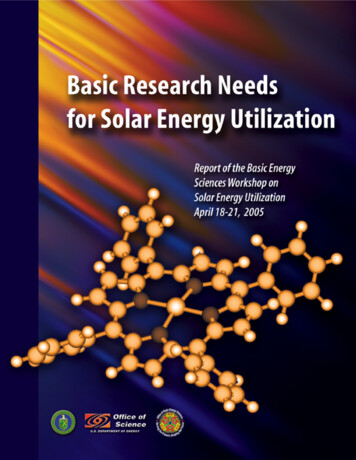
Transcription
On the Cover:One route to harvesting the energy of the sun involves learning to mimicnatural photosynthesis. Here, sunlight falls on a porphyrin, one member of afamily of molecules that includes the chlorophylls, which play a central rolein capturing light and using its energy for photosynthesis in green plants.Efficient light-harvesting of the solar spectrum by porphyrins and relatedmolecules can be used to power synthetic molecular assemblies and solidstate devices — applying the principles of photosynthesis to the production of hydrogen, methane, ethanol, and methanol from sunlight, water, andatmospheric carbon dioxide.
BASIC RESEARCH NEEDS FOR SOLAR ENERGY UTILIZATIONReport on the Basic Energy Sciences WorkshoponSolar Energy UtilizationChair:Co-chair:Nathan S. Lewis, California Institute of TechnologyGeorge Crabtree, Argonne National LaboratoryPanel Chairs:Solar ElectricSolar FuelsCross-cuttingArthur J. Nozik, National Renewable Energy LaboratoryMichael R. Wasielewski, Northwestern UniversityPaul Alivisatos, Lawrence Berkeley National LaboratoryOffice ofBasic EnergySciences Contact:Harriet Kung, Basic Energy Sciences, U.S. Department of EnergySpecial frey Tsao, Sandia National LaboratoriesElaine Chandler, Lawrence Berkeley National LaboratoryWladek Walukiewicz, Lawrence Berkeley National LaboratoryMark Spitler, National Renewable Energy LaboratoryRandy Ellingson, National Renewable Energy LaboratoryRalph Overend, National Renewable Energy LaboratoryJeffrey Mazer, Solar Energy Technologies, U.S. Department of EnergyMary Gress, Basic Energy Sciences, U.S. Department of EnergyJames Horwitz, Basic Energy Sciences, U.S. Department of EnergyChristie Ashton, Basic Energy Sciences, U.S. Department of EnergyBrian Herndon, Oak Ridge Institute for Science and EducationLeslie Shapard, Oak Ridge Institute for Science and EducationRenée M. Nault, Argonne National LaboratoryThis report is available on the web at http://www.sc.doe.gov/bes/reports/files/SEU rpt.pdf.
Revisions, September 2005p ix, paragraph 3: Yet, in 2001, solar electricity provided less than 0.1% of the world'selectricity, and solar fuel from modern (sustainable) biomass provided less than 1.5% of theworld's energy.p 9, paragraph 4: The required fuel would then have to be mined from seawater (requiringprocessing seawater at a rate equivalent to more than 1,000 Niagara Falls), or else breederreactor technology would have to be developed and disseminated to countries wishing to meettheir additional energy demand in this way.p 10, paragraph 1: The amount of energy produced by covering 0.16% of the Earth’s land areawith 10% efficient solar cells is equal to that produced by 20,000 1-GWe nuclear fission plants.This many plants would need to be constructed to meet global demands for carbon-neutralenergy in the second half of the 21st century if carbon sequestration were to prove technicallynonviable and if solar energy were not developed.ii
CONTENTSNotation.vExecutive Summary .ixIntroduction.1Global Energy Resources.7Reports of the Panels on Basic Research Needs for Solar Energy Utilization .Basic Research Challenges for Solar Electricity .Basic Research Challenges for Solar Fuels .Basic Research Challenges for Solar Thermal Utilization .Cross-cutting Research Challenges.1113335775Priority Research Directions .Revolutionary Photovoltaic Devices: 50% Efficient Solar Cells .Maximum Energy from Solar Photons at Low Cost: Designed PlasticPhotovoltaic Structures .Nanostructures for Solar Energy Conversion: Low Cost and High Efficiencies.Fuels from Water and Sunlight: New Photoelectrodes forEfficient Photoelectrolysis .Leveraging Photosynthesis for Sustainable Solar Production of Biofuels .Using a Bio-inspired Smart Matrix to Optimize Energy Landscapes forSolar Fuels Production.Solar-powered Catalysts for Energy-rich Fuels Formation .Bio-inspired Molecular Assemblies for Integrating Photon-to-fuels Pathways .Achieving Defect-tolerant and Self-repairing Solar Conversion Systems .Solar Thermochemical Fuel Production .New Experimental and Theoretical Tools to Enable Transformational Research.Solar Energy Conversion Materials by Design.Materials Architectures for Solar Energy: Assembling Complex Structures .8991127135139145149155161171Conclusion .179Appendix 1: Technology Assessments .Solar Electricity .Solar Fuels .Solar Thermal and Thermoelectrics.185187199213Appendix 2: Workshop Participants .229Appendix 3: Workshop Program .235iii101109117121
CONTENTS (CONT.)Appendix 4: Additional Reading .249Index .257iv
NOTATIONACRONYMS AND ABBREVIATIONSa-Si:HADAEZAMASFhydrogenated amorphous siliconanaerobic digesteragro ecological zoneair massAnderson, Schultz, and FloryBOSbalance of systemCBCHPCOPCPVconduction bandcombined heat and powercoefficient of performanceconcentrated photovoltaicdcDNADNIDOEdirect currentdeoxyribonucleic aciddirect normal irradiationU.S. Department of EnergyEFGEIAEPVedge-defined film-fed growthEnergy Information Administrationelectrochemical photovoltaicF-TFTLFischer-TropschFischer-Tropsch liquidHCPVHHVhigh-concentration photovoltaichigher heating valueIPCCIRIntergovernmental Panel on Climate ChangeinfraredLFGLH1/LH2landfill gaslight-harvesting pigment/protein complexesMBEMEGMESPMOCVDmolecular beam epitaxymultiple exciton generationminimum ethanol selling pricemetalorganic chemical vapor depositionNAENHENRCNational Academy of Engineeringnormal hydrogen electrodeNational Research Councilv
OECoxygen-evolving complexPCETPCMPECPEMPRDPSIPSIIPVproton-coupled electron transferphase change storage materialphotoelectrochemicalproton exchange membranepriority research directionsphotosystem Iphotosystem IIphotovoltaicR&DRCresearch and developmentreaction centerTCOTMSTPVtransparent conducting oxidetheoretical modeling and simulationthermophotovoltaicU.S.UVUnited StatesultravioletXAFSX-ray absorption fine-structure (spectroscopy)ZTthermoelectric figure of meritUNITS OF MEASURE C Wthdegree(s) Celsiusdollar(s) per re(s)billion barrelscentimeter(s)centimeter(s) per minuteelectron ule(s)gigatons (109 tons 1 billion tons)gigawatt(s) (109 W 1 billion watts)kilogram(s)kilowatt hour(s)kilowatt(s) (thermal)vi
r(s)megahertzmillimeter(s)megawatt(s) (106 W 1 million watts)megawatt(s) (electric)megawatt(s) (thermal)megawatt(s) per yearnanometer(s)nanometer(s) per secondpicosecond(s)pound(s) per square inchsecond(s)terawatt(s) (1012 W 1 trillion watts)watt(s)peak watt(s)year(s)vii
viii
EXECUTIVE SUMMARYWorld demand for energy is projected to more than double by 2050 and to more than triple bythe end of the century. Incremental improvements in existing energy networks will not beadequate to supply this demand in a sustainable way. Finding sufficient supplies of clean energyfor the future is one of society’s most daunting challenges.Sunlight provides by far the largest of all carbon-neutral energy sources. More energy fromsunlight strikes the Earth in one hour (4.3 1020 J) than all the energy consumed on the planet ina year (4.1 1020 J). We currently exploit this solar resource through solar electricity — a 7.5 billion industry growing at a rate of 35–40% per annum — and solar-derived fuel frombiomass, which provides the primary energy source for over a billion people.Yet, in 2001, solar electricity provided less than 0.1% of the world's electricity, and solar fuelfrom modern (sustainable) biomass provided less than 1.5% of the world's energy. The huge gapbetween our present use of solar energy and its enormous undeveloped potential defines a grandchallenge in energy research. Sunlight is a compelling solution to our need for clean, abundantsources of energy in the future. It is readily available, secure from geopolitical tension, and posesno threat to our environment through pollution or to our climate through greenhouse gases.This report of the Basic Energy Sciences Workshop on Solar Energy Utilization identifies thekey scientific challenges and research directions that will enable efficient and economic use ofthe solar resource to provide a significant fraction of global primary energy by the mid21st century. The report reflects the collective output of the workshop attendees, which included200 scientists representing academia, national laboratories, and industry in the United States andabroad, and the U.S. Department of Energy’s Office of Basic Energy Sciences and Office ofEnergy Efficiency and Renewable Energy.Solar energy conversion systems fall into three categories according to their primary energyproduct: solar electricity, solar fuels, and solar thermal systems. Each of the three genericapproaches to exploiting the solar resource has untapped capability well beyond its presentusage. Workshop participants considered the potential of all three approaches, as well as thepotential of hybrid systems that integrate key components of individual technologies into novelcross-disciplinary paradigms.SOLAR ELECTRICITYThe challenge in converting sunlight to electricity via photovoltaic solar cells is dramaticallyreducing the cost/watt of delivered solar electricity — by approximately a factor of 5–10 tocompete with fossil and nuclear electricity and by a factor of 25–50 to compete with primaryfossil energy. New materials to efficiently absorb sunlight, new techniques to harness the fullspectrum of wavelengths in solar radiation, and new approaches based on nanostructuredarchitectures can revolutionize the technology used to produce solar electricity. Thetechnological development and successful commercialization of single-crystal solar cellsdemonstrates the promise and practicality of photovoltaics, while novel approaches exploitingix
thin films, organic semiconductors, dye sensitization, and quantum dots offer fascinating newopportunities for cheaper, more efficient, longer-lasting systems. Many of the new approachesoutlined by the workshop participants are enabled by (1) remarkable recent advances in thefabrication of nanoscale architectures by novel top-down and bottom-up techniques;(2) advances in nanoscale characterization using electron, neutron, and x-ray scattering andspectroscopy; and (3) sophisticated computer simulations of electronic and molecular behavior innanoscale semiconductor assemblies using density functional theory. Such advances in the basicscience of solar electric conversion, coupled to the new semiconductor materials now available,could drive a revolution in the way that solar cells are conceived, designed, implemented, andmanufactured.SOLAR FUELSThe inherent day-night and sunny-cloudy cycles of solar radiation necessitate an effectivemethod to store the converted solar energy for later dispatch and distribution. The most attractiveand economical method of storage is conversion to chemical fuels. The challenge in solar fueltechnology is to produce chemical fuels directly from sunlight in a robust, cost-efficient fashion.For millennia, cheap solar fuel production from biomass has been the primary energy source onthe planet. For the last two centuries, however, energy demand has outpaced biomass supply.The use of existing types of plants requires large land areas to meet a significant portion ofprimary energy demand. Almost all of the arable land on Earth would need to be covered withthe fastest-growing known energy crops, such as switchgrass, to produce the amount of energycurrently consumed from fossil fuels annually. Hence, the key research goals are (1) applicationof the revolutionary advances in biology and biotechnology to the design of plants and organismsthat are more efficient energy conversion “machines,” and (2) design of highly efficient, allartificial, molecular-level energy conversion machines exploiting the principles of naturalphotosynthesis. A key element in both approaches is the continued elucidation — by means ofstructural biology, genome sequencing, and proteomics — of the structure and dynamicsinvolved in the biological conversion of solar radiation to sugars and carbohydrates. Therevelation of these long-held secrets of natural solar conversion by means of cutting-edgeexperiment and theory will enable a host of exciting new approaches to direct solar fuelproduction. Artificial nanoscale assemblies of new organic and inorganic materials andmorphologies, replacing natural plants or algae, can now use sunlight to directly produce H2 bysplitting water and hydrocarbons via reduction of atmospheric CO2. While these laboratorysuccesses demonstrate the appealing promise of direct solar fuel production by artificialmolecular machines, there is an enormous gap between the present state of the art and adeployable technology. The current laboratory systems are unstable over long time periods, tooexpensive, and too inefficient for practical implementation. Basic research is needed to developapproaches and systems to bridge the gap between the scientific frontier and practicaltechnology.x
SOLAR THERMAL SYSTEMSThe key challenge in solar thermal technology is to identify cost-effective methods to convertsunlight into storable, dispatchable thermal energy. Reactors heated by focused, concentratedsunlight in thermal towers reach temperatures exceeding 3,000 C, enabling the efficientchemical production of fuels from raw materials without expensive catalysts. New materials thatwithstand the high temperatures of solar thermal reactors are needed to drive applications of thistechnology. New chemical conversion sequences, like those that split water to produce H2 usingthe heat from nuclear fission reactors, could be used to convert focused solar thermal energy intochemical fuel with unprecedented efficiency and cost effectiveness. At lower solar concentrationtemperatures, solar heat can be used to drive turbines that produce electricity mechanically withgreater efficiency than the current generation of solar photovoltaics. When combined with solardriven chemical storage/release cycles, such as those based on the dissociation and synthesis ofammonia, solar engines can produce electricity continuously 24 h/day. Novel thermal storagematerials with an embedded phase transition offer the potential of high thermal storage capacityand long release times, bridging the diurnal cycle. Nanostructured thermoelectric materials, inthe form of nanowires or quantum dot arrays, offer a promise of direct electricity productionfrom temperature differentials with efficiencies of 20–30% over a temperature differential of afew hundred degrees Celsius. The much larger differentials in solar thermal reactors make evenhigher efficiencies possible. New low-cost, high-performance reflective materials for thefocusing systems are needed to optimize the cost effectiveness of all concentrated solar thermaltechnologies.PRIORITY RESEARCH DIRECTIONSWorkshop attendees identified thirteen priority research directions (PRDs) with high potentialfor producing scientific breakthroughs that could dramatically advance solar energy conversionto electricity, fuels, and thermal end uses. Many of these PRDs address issues of concern to morethan one approach or technology. These cross-cutting issues include (1) coaxing cheap materialsto perform as well as expensive materials in terms of their electrical, optical, chemical, andphysical properties; (2) developing new paradigms for solar cell design that surpass traditionalefficiency limits; (3) finding catalysts that enable inexpensive, efficient conversion of solarenergy into chemical fuels; (4) identifying novel methods for self-assembly of molecularcomponents into functionally integrated systems; and (5) developing materials for solar energyconversion infrastructure, such as transparent conductors and robust, inexpensive thermalmanagement materials.A key outcome of the workshop is the sense of optimism in the cross-disciplinary community ofsolar energy scientists spanning academia, government, and industry. Although large barriersprevent present technology from producing a significant fraction of our primary energy fromsunlight by the mid-21st century, workshop participants identified promising routes for basicresearch that can bring this goal within reach. Much of this optimism is based on the continuing,rapid worldwide progress in nanoscience. Powerful new methods of nanoscale fabrication,characterization, and simulation — using tools that were not available as little as five years ago— create new opportunities for understanding and manipulating the molecular and electronicpathways of solar energy conversion. Additional optimism arises from impressive strides inxi
genetic sequencing, protein production, and structural biology that will soon bring the secrets ofphotosynthesis and natural bio-catalysis into sharp focus. Understanding these highly effectivenatural processes in detail will allow us to modify and extend them to molecular reactions thatdirectly produce sunlight-derived fuels that fit seamlessly into our existing energy networks. Therapid advances on the scientific frontiers of nanoscience and molecular biology provide a strongfoundation for future breakthroughs in solar energy conversion.xii
INTRODUCTION1
2
INTRODUCTIONThe supply and demand of energy determine the course of global development in every sphere ofhuman activity. Sufficient supplies of clean energy are intimately linked with global stability,economic prosperity, and quality of life. Finding energy sources to satisfy the world’s growingdemand is one of society’s foremost challenges for the next half-century. The importance of thispervasive problem and the perplexing technical difficulty of solving it require a concertednational effort marshalling our most advanced scientific and technological capabilities.THE ENERGY CHALLENGEThe world now uses energy at a rate of approximately 4.1 1020 joules/yr, equivalent to acontinuous power consumption of 13 trillion watts, or 13 terawatts (TW). Even with aggressiveconservation and energy efficiency measures, an increase of the Earth’s population to 9 billionpeople, accompanied by rapid technology development and economic growth world-wide, isprojected to produce more than double the demand for energy (to 30 TW) by 2050, and morethan triple the demand (to 46 TW) by the end of the century. The reserves of fossil fuels thatcurrently power society will fall short of this demand over the long term, and their continued useproduces harmful side effects such as pollution that threatens human health and greenhousegases associated with climate change. Alternative renewable fuels are at present far fromcompetitive with fossil fuels in cost and production capacity. Without viable options forsupplying double or triple today’s energy use, the world’s economic, technological, and politicalhorizons will be severely limited.SOLAR ENERGYOur primary source of clean, abundant energy is the sun. The sun deposits 120,000 TW ofradiation on the surface of the Earth, far exceeding human needs even in the most aggressiveenergy demand scenarios. The sun is Earth’s natural power source, driving the circulation ofglobal wind and ocean currents, the cycle of water evaporation and condensation that createsrivers and lakes, and the biological cycles of photosynthesis and life. Covering 0.16% of the landon Earth with 10% efficient solar conversion systems would provide 20 TW of power, nearlytwice the world’s consumption rate of fossil energy and the equivalent 20,000 1-GWe nuclearfission plants. These comparisons illustrate the impressive magnitude of the solar resource,providing an energy stream far more potent than present-day human technology can achieve.All routes for utilizing solar energy exploit the functional steps of capture, conversion, andstorage. The sun’s energy arrives on Earth as radiation distributed across the color spectrumfrom infrared to ultraviolet. The energy of this radiation must be captured as excited electronhole pairs in a semiconductor, a dye, or a chromophore, or as heat in a thermal storage medium.Excited electrons and holes can be tapped off for immediate conversion to electrical power, ortransferred to biological or chemical molecules for conversion to fuel. Natural photosynthesisproduces fuel in the form of sugars and other carbohydrates derived from the reduction of CO2 inthe atmosphere and used to power the growth of plants. The plants themselves become available3
as biomass for combustion as primary fuels or for conversion in reactors to secondary fuels likeliquid ethanol or gaseous carbon monoxide, methane, and hydrogen. We are now learning tomimic the natural photosynthetic process in the laboratory using artificial molecular assemblies,where the excited electrons and holes can drive chemical reactions to produce fuels that link toour existing energy networks. Atmospheric CO2 can be reduced to ethanol or methane, or watercan be split to create hydrogen. These fuels are the storage media for solar energy, bridging thenatural day-night, winter-summer, and cloudy-sunny cycles of solar radiation.In addition to electric and chemical conversion routes, solar radiation can be converted to heatenergy. Solar concentrators focus sunlight collected over a large area to a line or spot where heatis collected in an absorber. Temperatures as high as 3,000 C can be generated to drive chemicalreactions, or heat can be collected at lower temperatures and transferred to a thermal storagemedium like water for distributed space heating or steam to drive an engine. Effective storage ofsolar energy as heat requires developing thermal storage media that accumulate heat efficientlyduring sunny periods and release heat slowly during dark or cloudy periods. Heat is one of themost versatile forms of energy, the common link in nearly all our energy networks. Solar thermalconversion can replace much of the heat now supplied by fossil fuel.Although many routes use solar energy to produce electricity, fuel, and heat, none are currentlycompetitive with fossil fuels for a combination of cost, reliability, and performance. Solarelectricity from photovoltaics is too costly, by factors of 5–10, to compete with fossil-derivedelectricity, and is too costly by factors of 25–50 to compete with fossil fuel as a primary energysource. Solar fuels in the form of biomass produce electricity and heat at costs that are withinrange of fossil fuels, but their production capacity is limited. The low efficiency with which theyconvert sunlight to stored energy means large land areas are required. To produce the full 13 TWof power used by the planet, nearly all the arable land on Earth would need to be planted withswitchgrass, the fastest-growing energy crop. Artificial photosynthetic systems are promisingroutes for converting solar energy to fuels, but they are still in the laboratory stage where theprinciples of their assembly and functionality are being explored. Solar thermal systems providethe lowest-cost solar electricity at the present time, but require large areas in the Sun Belt andbreakthroughs in materials to become economically competitive with fossil energy as a primaryenergy source. While solar energy has enormous promise as a clean, abundant, economicalenergy source, it presents formidable basic research challenges in designing materials and inunderstanding the electronic and molecular basis of capture, conversion, and storage before itspromise can be realized.THE WORKSHOP ON SOLAR ENERGY UTILIZATIONThe U.S. Department of Energy (DOE) Office of Basic Energy Sciences held a Workshop onSolar Energy Utilization on April 18–21, 2005, in Bethesda, Maryland, to examine thechallenges and opportunities for the development of solar energy as a competitive energy source.The workshop brought together 200 participants representing the basic science and technology ofsolar energy utilization. Participants were drawn from academia, industry, and nationallaboratories in the United States, Europe, and Asia, with interdisciplinary expertise spanningphysics, chemistry, biology, materials, and engineering. Their charge was to identify thetechnical barriers to large-scale implementation of solar energy and the basic research directions4
showing promise to overcome them. The workshop focused on the grand challenges in solarenergy research, where scientific breakthroughs will produce revolutionary, not evolutionary,progress in bringing solar conversion a significant share of the energy marketplace.The workshop comprised panels that examined the conversion of solar energy into three endproducts: solar electricity, solar fuels, and solar thermal conversion. The chairs of the panels andsubpanels were drawn from universities, research institutions, and national laboratories. PatDehmer, Director of DOE’s Office of Basic Energy Sciences, launched the opening plenarysession of the workshop, presenting the charge to participants and the scope. Energy expertsfrom academia and industry set the stage with plenary talks on future energy demand, potentialsources of supply, the impact of energy on environment, and the status of commercial solartechnologies. Scientists from the DOE’s Office of Energy Efficiency and Renewable Energybriefed the participants on the accomplishments and outlook for its solar energy programs. Thechairs of the workshop panels presented the current scientific status and the grand challenges insolar electric, solar fuels, and solar thermal conversion.Following the opening plenary session, the participants divided into panels and subpanelsexamining solar electric, solar fuels, and solar thermal conversion options (see Appendix 3 forthe workshop schedule). Each of these panels invited expert speakers to analyze the grandchallenges and scientific routes to achieve them. The sub-panels then developed a set of highpriority research directions with potential to produce revolutionary, not evolutionary,breakthroughs in materials and processes for solar energy utilization. These Priority ResearchDirections (PRDs) are the major output of the workshop and are presented in this report.SOLAR ENERGY OUTLOOKThe scientific stage is set for rapid progress in solar energy research. The last five years haveseen rapid advances in nanoscience and nanotechnology, allowing unprecedented manipulationof the nanoscale structures controlling solar capture, conversion, and storage. Light interacts withmaterials on the scale of its wavelength, a few hundred nanometers. Energy capture occurs viaexcited electron states confined by defect structures or interfaces to dimensions of tens ofnanometers. Conversion of excited electrons to fuels such as ethanol, methane, or hydrogenoccurs in chemical reactions at the scale of molecules. These nanoscale processes have neverbeen more accessible to observation and manipulation. Advances in fabrication of nanoscalestructures by top-down lithography and bottom-up self-assembly are rapidly broadening ourhorizons for creating and interconnecting the functional units for capture, conversion, andstorage of solar energy. Parallel advances in experimental tools that probe complex systems atever shorter length and time scales by electron, X-ray, and neutron scattering at major facilitiesand by the explosion of scanning probe microscopies at the benchtop are now revealing secretsof electron transfer, catalytic activity, and chemical transformation that have long been hidden.Advances in density functional theory coupled with multinode computational clusters n
technology is to produce chemical fuels directly from sunlight in a robust, cost-efficient fashion. For millennia, cheap solar fuel production from biomass has been the primary energy source on the planet. For the last two centuries, however, energy demand has outpaced biomass supply.







![Office 2010 Professional Plus Com Ativador Serial Keyl [EXCLUSIVE]](/img/61/office-2010-professional-plus-com-ativador-serial-keyl-exclusive.jpg)



